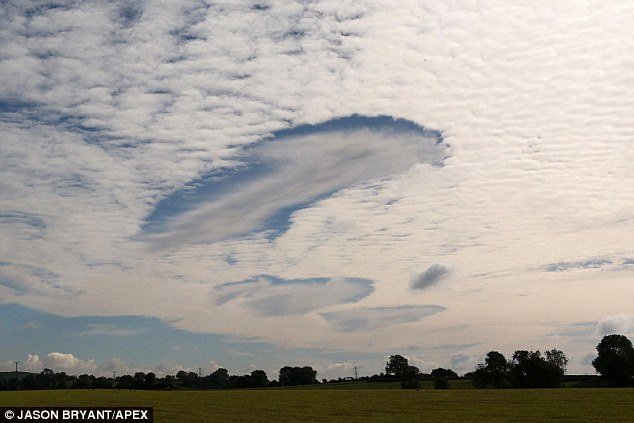
Residents in Somerset were in for a surprise this morning, when they spotted what could easily be mistaken for a UFO in the sky.
The rare atmospheric phenomenon is a strange cloud formation, known as fallstreak, or hole-punch clouds.
Experts say the stunning clouds that look like a brushstrokes are caused by a rare - but rather ordinary - atmospheric occurrence.
The bizarre clouds were snapped over Shepton Mallet, in Somerset.
These unfamiliar clouds form when temperatures are below freezing, but water droplets in the clouds have yet to freeze due to a lack of ice particles.
When ice particles form quickly, it causes a domino effect as the water droplets connect with the crystals, which get heavier and then start to fall all of a sudden - leaving a large hole in the cloud.
The wispy clouds that form in the center of the hole are the water particles falling.
Passing airplanes are thought to be the reason behind the formation of these clouds, since a drop in pressure caused by their wings or propeller tips cools the air quickly.
Hole-punch cloudsRainbows are sometimes seen with fallstreak clouds, thanks to light refracting off the water droplets.
A fallstreak hole forms when part of the cloud layer forms ice crystals which are large enough to fall as a 'fallstreak'.
They form in clouds of supercooled water droplets - water below 0°C but not yet frozen.
These water droplets need a tiny particle to freeze or to be cooled below -40 °C.
Aircraft punching through this cloud layer can cause air to expand and cool as it passes over the aircraft wings or propeller.
This change in temperature can be enough to encourage the supercooled droplets to freeze and fall from the cloud layer in this distinctive pattern.
Weather Network meteorologist Erin Wenckstern explained: 'While they can be found worldwide, a skypunch is rather rare and the phenomenon is hard to explain.
'High up in the sky, thin clouds made from supercooled liquid water - meaning temperatures are below freezing, but cannot freeze in crystals - are disturbed as an aircraft punches through and cools the surrounding air, eventually forming ice crystals due to a drop in pressure.
'The ice crystals then cause the surrounding water droplets to evaporate, leaving a distinctive hole in the sky.'



I've noticed because this was similar to a certain battlecruiser from a certain computer game. Later I observed similar, but smaller holes in the area. I'm not sure if this is an anomaly. The article says it's just rare.